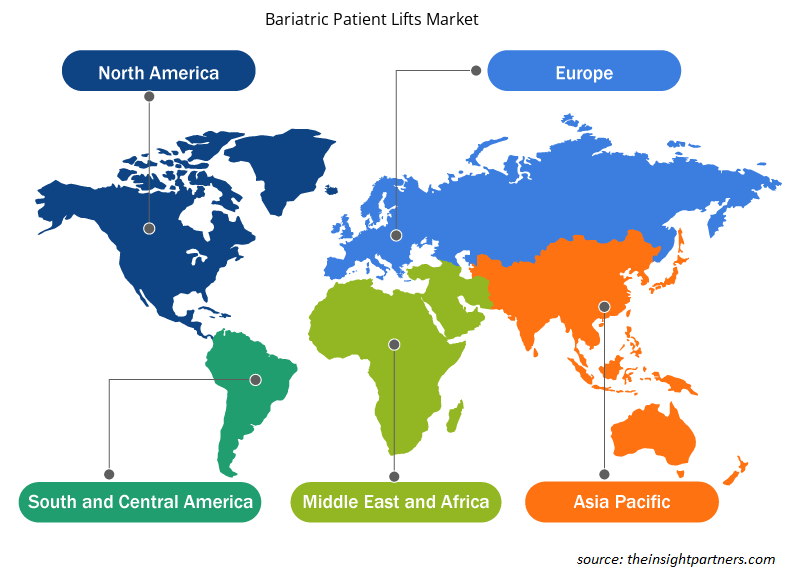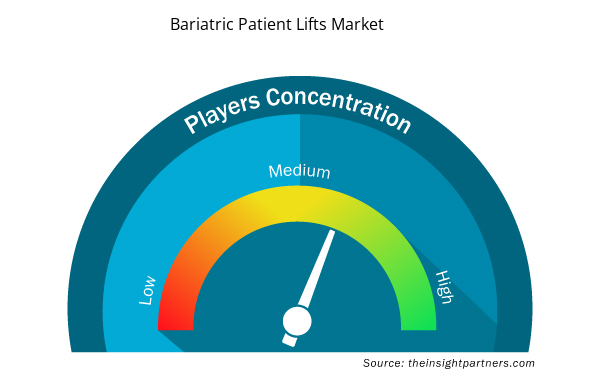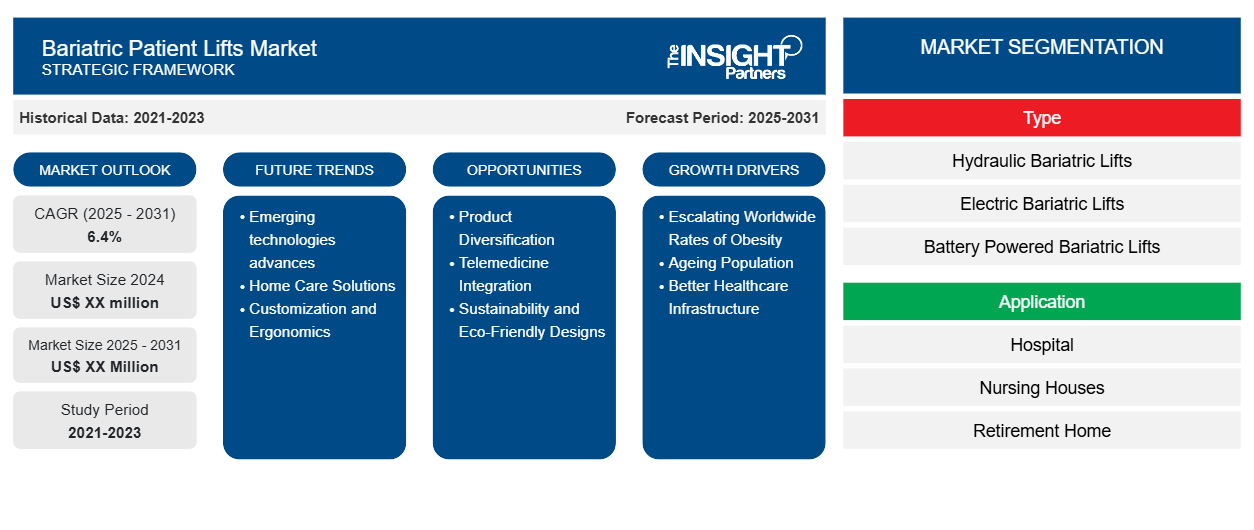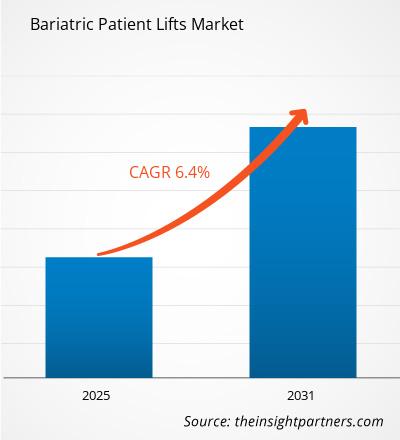Der Markt für bariatrische Patientenlifter wird voraussichtlich von 2023 bis 2031 eine durchschnittliche jährliche Wachstumsrate von 6,4 % verzeichnen, wobei die Marktgröße von XX Millionen US-Dollar im Jahr 2023 auf XX Millionen US-Dollar bis 2031 wachsen wird.
Der Bericht ist nach Typ segmentiert (hydraulische bariatrische Lifte, elektrische bariatrische Lifte, batteriebetriebene bariatrische Lifte). Der Bericht ist nach Anwendung segmentiert (Krankenhaus, Pflegeheim, Altenheim, Sonstiges). Die globale Analyse ist weiter auf regionaler Ebene und nach wichtigen Ländern aufgeschlüsselt. Der Bericht bietet den Wert in USD für die oben genannte Analyse und Segmente.
Zweck des Berichts
Der Bericht „Markt für bariatrische Patientenlifte“ von The Insight Partners soll die aktuelle Situation und das zukünftige Wachstum sowie die wichtigsten treibenden Faktoren, Herausforderungen und Chancen beschreiben. Dies wird verschiedenen Geschäftspartnern Einblicke geben, wie zum Beispiel:
- Technologieanbieter/-hersteller: Um die sich entwickelnde Marktdynamik zu verstehen und die potenziellen Wachstumschancen zu kennen, damit sie fundierte strategische Entscheidungen treffen können.
- Investoren: Durchführung einer umfassenden Trendanalyse hinsichtlich der Marktwachstumsrate, der finanziellen Marktprognosen und der Chancen entlang der Wertschöpfungskette.
- Regulierungsbehörden: Sie regulieren Richtlinien und polizeiliche Maßnahmen auf dem Markt mit dem Ziel, Missbrauch zu minimieren, das Vertrauen der Anleger zu bewahren und die Integrität und Stabilität des Marktes aufrechtzuerhalten.
Marktsegmentierung für bariatrische Patientenlifte
Typ
- Hydraulische Adipositas-Lifte
- Elektrische Adipositas-Lifts
- Batteriebetriebene Adipositas-Lifte
Anwendung
- Krankenhaus
- Pflegeheime
- Altenheim
- Sonstiges
Passen Sie diesen Bericht Ihren Anforderungen an
Sie erhalten kostenlos individuelle Anpassungen an jedem Bericht, einschließlich Teilen dieses Berichts oder einer Analyse auf Länderebene, eines Excel-Datenpakets sowie tolle Angebote und Rabatte für Start-ups und Universitäten.
- Holen Sie sich die wichtigsten Markttrends aus diesem Bericht.Dieses KOSTENLOSE Beispiel umfasst eine Datenanalyse von Markttrends bis hin zu Schätzungen und Prognosen.
Wachstumstreiber auf dem Markt für bariatrische Patientenlifter
- Weltweit steigende Fettleibigkeitsraten: Die weltweit steigenden Werte haben zu einem rasanten Anstieg des Marktes für bariatrische Patientenlifte geführt. Laut der Weltgesundheitsorganisation (WHO) hat sich die Fettleibigkeit seit 1975 mehr als verdreifacht. Dennoch werden auf allen Kontinenten immer mehr Menschen übergewichtig und fettleibig, besonders hoch scheint dies in Nordamerika, Europa und einigen Teilen des asiatisch-pazifischen Raums zu sein. Dies trägt zu einer steigenden Nachfrage nach mehr bariatrischer Gesundheitsausrüstung, einschließlich Liftern, bei. Bariatrische Patientenlifte sind sehr wichtig, um fettleibige Patienten sicher und effektiv zu transportieren und ihnen beim Transport in Krankenhäusern, zu Hause und in Pflegeheimen ein Gefühl der Würde zu geben.
- Alternde Bevölkerung: Ein weiterer wichtiger Antriebsfaktor für den Markt ist die alternde Weltbevölkerung. Ältere Menschen haben viele Mobilitätsprobleme und viele leiden auch an Begleiterkrankungen, die zu Fettleibigkeit führen können. Mit der längeren Lebenserwartung steigt auch die Nachfrage nach Geräten, die den Patienten mehr Mobilität ermöglichen. Daher werden bariatrische Patientenlifter ein wesentlicher Bestandteil der Altenpflege sein, in der Patienten oft mit Mobilitätseinschränkungen konfrontiert sind und die Sicherheit der Patienten aufgrund geriatrischer Patienten oberste Priorität hat.
- Bessere Gesundheitsinfrastruktur: In vielen Regionen der Welt investieren viele Regierungen in die Verbesserung der Gesundheitsinfrastruktur. Schwellenmärkte investieren in das Gesundheitswesen und kaufen Geräte, um die Patientenversorgung zu verbessern und die Sicherheit des Gesundheitspersonals zu gewährleisten. Da die Patientenergebnisse verbessert und das Verletzungsrisiko gesenkt werden, betrachten Gesundheitsdienstleister bariatrische Lifter immer häufiger als Standardausrüstung in Einrichtungen, in denen schwergewichtige Patienten betreut werden – in Krankenhäusern, Rehabilitationszentren und in der häuslichen Pflege.
Markttrends für bariatrische Patientenlifter
- Fortschritte bei neuen Technologien: Der Markt für bariatrische Patientenlifter wird durch die Erfindung intelligenterer und effizienterer Hebesysteme neu gestaltet. Die modernen bariatrischen Lifter verfügen über die neuesten Entwicklungen wie elektronische Steuerungen, Fernüberwachung und verbesserte Gewichtssensoren. Diese Weiterentwicklung macht das Heben für Patienten und Pflegepersonal gleichermaßen präzise, komfortabel und sicher. Drahtlose Technologien sowie die Integration mit Gesundheitssystemen zur Patientendatenverfolgung werden für einen nahtlosen Arbeitsablauf und eine verbesserte Patientenversorgung integriert.
- Lösungen für die häusliche Pflege: Obwohl dadurch der Bedarf an häuslicher Pflege und die mit der Krankenhauspflege verbundenen Kosten steigen, entscheiden sich immer mehr Patienten für die Pflege zu Hause. Eine neue Reihe bariatrischer Patientenlifter wurde speziell für den Heimgebrauch entwickelt, da sie immer kompakter, günstiger und einfacher zu bedienen sind. Dies gibt Herstellern die Möglichkeit, Geräte herzustellen, die Anforderungen wie Tragbarkeit, Benutzerfreundlichkeit und diskrete Designs erfüllen, die sich in das Zuhause einfügen.
- Anpassung und Ergonomie: Lifter sind flexibler geworden, sodass Gesundheitsdienstleister selbst Lifter auswählen können, die sie für bariatrische Patienten geeignet finden. Einstellbare Breite, Höhe und Armlehnen werden zu Standardfunktionen, die Komfort und Sicherheit während des Transferprozesses gewährleisten. Darüber hinaus werden Patienten und Pflegekräfte nicht stark belastet, da bei der Gestaltung von Liftern auch ergonomische Designs berücksichtigt werden, was zu besseren Ergebnissen beiträgt.
Marktchancen für bariatrische Patientenlifter
- Produktdiversifizierung: Daher könnte der Hersteller zahlreiche Möglichkeiten aus der Diversifizierung seines Produktportfolios ziehen. Beispielsweise könnte der Adipositaslifter zusammen mit anderen assistierten Technologien wie dem Adipositasbett, dem Duschstuhl oder sogar solchen atypischen Rollstühlen in umfassende Lösungen für die Patientenversorgung integriert werden. Außerdem könnte es eine Website geben, auf der Unternehmen bessere Möglichkeiten für Mietservices oder Abonnementmodelle für Adipositasgeräte finden könnten, vor allem aufgrund der begrenzten Möglichkeit, teure Geräte im Voraus zu kaufen, die von Anbietern häuslicher Gesundheitspflege angeboten werden.
- Telemedizin-Integration: Die Telemedizin-Integration ist ein weiterer Bereich, in dem bariatrische Lifts ihre Spuren hinterlassen können. Da Telemedizin schnell zur Norm wird, könnte sie die Integration bariatrischer Lifts in Telegesundheitsplattformen ermöglichen. Beispielsweise können Benutzertrends von Pflegekräften feststellen, ob bei einem Patienten bestimmte Eingriffe notwendig sind. Dies kann bei der Behandlung chronischer Erkrankungen wie Fettleibigkeit wichtig sein, die eine kontinuierliche Pflege und Überwachung erfordern.
- Nachhaltigkeit und umweltfreundliches Design: Patienten fordern auch zunehmend nachhaltige Optionen im Gesundheitswesen. Sie können Unternehmen nun die Möglichkeit bieten, bariatrische Lifts aus umweltfreundlichen Materialien, energieeffizienten Systemen und recycelbaren Komponenten herzustellen. Auf diese Weise wird der ökologische Fußabdruck dieser Geräte verringert und sie werden auch das Auge des umweltbewussten Verbrauchers und der auf Nachhaltigkeit ausgerichteten Gesundheitseinrichtungen erfreuen.
Regionale Einblicke in den Markt für bariatrische Patientenlifte
Die regionalen Trends und Faktoren, die den Markt für bariatrische Patientenlifte im gesamten Prognosezeitraum beeinflussen, wurden von den Analysten von Insight Partners ausführlich erläutert. In diesem Abschnitt werden auch Marktsegmente und Geografie für bariatrische Patientenlifte in Nordamerika, Europa, im asiatisch-pazifischen Raum, im Nahen Osten und Afrika sowie in Süd- und Mittelamerika erörtert.

- Erhalten Sie regionale Daten zum Markt für bariatrische Patientenlifte
Umfang des Marktberichts über bariatrische Patientenlifte
| Berichtsattribut | Details |
|---|---|
| Marktgröße im Jahr 2023 | XX Millionen US-Dollar |
| Marktgröße bis 2031 | XX Millionen US-Dollar |
| Globale CAGR (2023 - 2031) | 6,4 % |
| Historische Daten | 2021-2022 |
| Prognosezeitraum | 2024–2031 |
| Abgedeckte Segmente | Nach Typ
|
| Abgedeckte Regionen und Länder | Nordamerika
|
| Marktführer und wichtige Unternehmensprofile |
|
Marktteilnehmerdichte für bariatrische Patientenlifte: Auswirkungen auf die Geschäftsdynamik verstehen
Der Markt für bariatrische Patientenlifte wächst rasant, angetrieben durch die steigende Nachfrage der Endnutzer aufgrund von Faktoren wie sich entwickelnden Verbraucherpräferenzen, technologischen Fortschritten und einem größeren Bewusstsein für die Vorteile des Produkts. Mit steigender Nachfrage erweitern Unternehmen ihr Angebot, entwickeln Innovationen, um die Bedürfnisse der Verbraucher zu erfüllen, und nutzen neue Trends, was das Marktwachstum weiter ankurbelt.
Die Marktteilnehmerdichte bezieht sich auf die Verteilung der Firmen oder Unternehmen, die in einem bestimmten Markt oder einer bestimmten Branche tätig sind. Sie gibt an, wie viele Wettbewerber (Marktteilnehmer) in einem bestimmten Marktraum im Verhältnis zu seiner Größe oder seinem gesamten Marktwert präsent sind.
Die wichtigsten Unternehmen auf dem Markt für bariatrische Patientenlifte sind:
- Stryker Corporation
- Invacare Corporation
- Arjo
- Hill-Rom Services, Inc
- Handicare
Haftungsausschluss : Die oben aufgeführten Unternehmen sind nicht in einer bestimmten Reihenfolge aufgeführt.

- Überblick über die wichtigsten Akteure auf dem Markt für bariatrische Patientenlifte
Wichtige Verkaufsargumente
- Umfassende Abdeckung: Der Bericht deckt die Analyse der Produkte, Dienste, Typen und Endbenutzer des Marktes für bariatrische Patientenlifte umfassend ab und bietet einen ganzheitlichen Überblick.
- Expertenanalyse: Der Bericht basiert auf dem umfassenden Verständnis von Branchenexperten und Analysten.
- Aktuelle Informationen: Der Bericht stellt durch die Abdeckung aktueller Informationen und Datentrends Geschäftsrelevanz sicher.
- Anpassungsoptionen: Dieser Bericht kann angepasst werden, um spezifische Kundenanforderungen zu erfüllen und die Geschäftsstrategien optimal anzupassen.
Der Forschungsbericht zum Markt für bariatrische Patientenlifte kann daher dabei helfen, die Branchensituation und Wachstumsaussichten zu entschlüsseln und zu verstehen. Obwohl es einige berechtigte Bedenken geben kann, überwiegen die allgemeinen Vorteile dieses Berichts tendenziell die Nachteile.
- Historische Analyse (2 Jahre), Basisjahr, Prognose (7 Jahre) mit CAGR
- PEST- und SWOT-Analyse
- Marktgröße Wert/Volumen – Global, Regional, Land
- Branche und Wettbewerbsumfeld
- Excel-Datensatz



Report Coverage
Revenue forecast, Company Analysis, Industry landscape, Growth factors, and Trends

Segment Covered
This text is related
to segments covered.

Regional Scope
North America, Europe, Asia Pacific, Middle East & Africa, South & Central America

Country Scope
This text is related
to country scope.
Häufig gestellte Fragen
The Bariatric Patient Lifts Market is estimated to witness a CAGR of 6.4% from 2023 to 2031
The major factors driving the Bariatric Patient Lifts market are:
1. Escalating Worldwide Rates of Obesity
2. Ageing Population
Product Diversification act as a opportunity for growth of the market in forecast period.
North America region dominated the Bariatric Patient Lifts market in 2023.
Hydraulic Bariatric Lifts segment, by type, dominated the market in 2023.
Players operating in the market are Stryker Corporation, Invacare Corporation, Arjo, Hill,Rom Services, Inc, Handicare, Vancare, Joerns Healthcare LLC, Gainsborough Healthcare Group, Guldmann, VITAL MOBILITY MEDICAL SUPPLIES INC.
Trends and growth analysis reports related to Life Sciences : READ MORE..
- Stryker Corporation
- Invacare Corporation
- Arjo
- Hill-Rom Services, Inc
- Handicare
- Vancare
- Joerns Healthcare LLC
- Gainsborough Healthcare Group
- Guldmann
- VITAL MOBILITY MEDICAL SUPPLIES INC.
The Insight Partners performs research in 4 major stages: Data Collection & Secondary Research, Primary Research, Data Analysis and Data Triangulation & Final Review.
- Data Collection and Secondary Research:
As a market research and consulting firm operating from a decade, we have published and advised several client across the globe. First step for any study will start with an assessment of currently available data and insights from existing reports. Further, historical and current market information is collected from Investor Presentations, Annual Reports, SEC Filings, etc., and other information related to company’s performance and market positioning are gathered from Paid Databases (Factiva, Hoovers, and Reuters) and various other publications available in public domain.
Several associations trade associates, technical forums, institutes, societies and organization are accessed to gain technical as well as market related insights through their publications such as research papers, blogs and press releases related to the studies are referred to get cues about the market. Further, white papers, journals, magazines, and other news articles published in last 3 years are scrutinized and analyzed to understand the current market trends.
- Primary Research:
The primarily interview analysis comprise of data obtained from industry participants interview and answers to survey questions gathered by in-house primary team.
For primary research, interviews are conducted with industry experts/CEOs/Marketing Managers/VPs/Subject Matter Experts from both demand and supply side to get a 360-degree view of the market. The primary team conducts several interviews based on the complexity of the markets to understand the various market trends and dynamics which makes research more credible and precise.
A typical research interview fulfils the following functions:
- Provides first-hand information on the market size, market trends, growth trends, competitive landscape, and outlook
- Validates and strengthens in-house secondary research findings
- Develops the analysis team’s expertise and market understanding
Primary research involves email interactions and telephone interviews for each market, category, segment, and sub-segment across geographies. The participants who typically take part in such a process include, but are not limited to:
- Industry participants: VPs, business development managers, market intelligence managers and national sales managers
- Outside experts: Valuation experts, research analysts and key opinion leaders specializing in the electronics and semiconductor industry.
Below is the breakup of our primary respondents by company, designation, and region:

Once we receive the confirmation from primary research sources or primary respondents, we finalize the base year market estimation and forecast the data as per the macroeconomic and microeconomic factors assessed during data collection.
- Data Analysis:
Once data is validated through both secondary as well as primary respondents, we finalize the market estimations by hypothesis formulation and factor analysis at regional and country level.
- Macro-Economic Factor Analysis:
We analyse macroeconomic indicators such the gross domestic product (GDP), increase in the demand for goods and services across industries, technological advancement, regional economic growth, governmental policies, the influence of COVID-19, PEST analysis, and other aspects. This analysis aids in setting benchmarks for various nations/regions and approximating market splits. Additionally, the general trend of the aforementioned components aid in determining the market's development possibilities.
- Country Level Data:
Various factors that are especially aligned to the country are taken into account to determine the market size for a certain area and country, including the presence of vendors, such as headquarters and offices, the country's GDP, demand patterns, and industry growth. To comprehend the market dynamics for the nation, a number of growth variables, inhibitors, application areas, and current market trends are researched. The aforementioned elements aid in determining the country's overall market's growth potential.
- Company Profile:
The “Table of Contents” is formulated by listing and analyzing more than 25 - 30 companies operating in the market ecosystem across geographies. However, we profile only 10 companies as a standard practice in our syndicate reports. These 10 companies comprise leading, emerging, and regional players. Nonetheless, our analysis is not restricted to the 10 listed companies, we also analyze other companies present in the market to develop a holistic view and understand the prevailing trends. The “Company Profiles” section in the report covers key facts, business description, products & services, financial information, SWOT analysis, and key developments. The financial information presented is extracted from the annual reports and official documents of the publicly listed companies. Upon collecting the information for the sections of respective companies, we verify them via various primary sources and then compile the data in respective company profiles. The company level information helps us in deriving the base number as well as in forecasting the market size.
- Developing Base Number:
Aggregation of sales statistics (2020-2022) and macro-economic factor, and other secondary and primary research insights are utilized to arrive at base number and related market shares for 2022. The data gaps are identified in this step and relevant market data is analyzed, collected from paid primary interviews or databases. On finalizing the base year market size, forecasts are developed on the basis of macro-economic, industry and market growth factors and company level analysis.
- Data Triangulation and Final Review:
The market findings and base year market size calculations are validated from supply as well as demand side. Demand side validations are based on macro-economic factor analysis and benchmarks for respective regions and countries. In case of supply side validations, revenues of major companies are estimated (in case not available) based on industry benchmark, approximate number of employees, product portfolio, and primary interviews revenues are gathered. Further revenue from target product/service segment is assessed to avoid overshooting of market statistics. In case of heavy deviations between supply and demand side values, all thes steps are repeated to achieve synchronization.
We follow an iterative model, wherein we share our research findings with Subject Matter Experts (SME’s) and Key Opinion Leaders (KOLs) until consensus view of the market is not formulated – this model negates any drastic deviation in the opinions of experts. Only validated and universally acceptable research findings are quoted in our reports.
We have important check points that we use to validate our research findings – which we call – data triangulation, where we validate the information, we generate from secondary sources with primary interviews and then we re-validate with our internal data bases and Subject matter experts. This comprehensive model enables us to deliver high quality, reliable data in shortest possible time.


 Holen Sie sich ein kostenloses Muster für diesen Bericht
Holen Sie sich ein kostenloses Muster für diesen Bericht